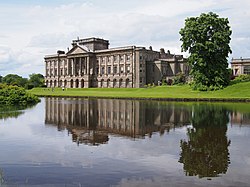 Lyme Park, the former seat of the Legh family | |
| Language(s) | English |
|---|---|
| Origin | |
| Region of origin | Cheshire, North West England |
| Other names | |
| Variant form(s) | Lee, Legh, Leigh |
| Burke's Peerage & Baronetage and Burke's Landed Gentry | |
The Leghs of Lyme were a gentry family seated at Lyme Park in Cheshire, England, from 1398 until 1946, when the stately home and its surrounding parkland were donated by the 3rd Lord Newton to The National Trust.
Contents
Since the Middle Ages various spellings of this ancient surname have been used : Legh, a Lee, Leghe, Leigh and Leyghe; there were also variations on Peter, eg. Piers and Peers, the family's most oft-used given name. [1] The first Sir Piers Legh, of Lyme, was knighted in 1397 and assumed as a coat of arms those of his mother, Matilda de Norley, in lieu of his ancient patrilineal Leigh arms. [2]
For ease of distinguishing between the earlier generations, it became customary to append a Roman numeral to the various Leghs' names; in this case the numbering system is as used in The National Trust Handbook for Lyme Park.
